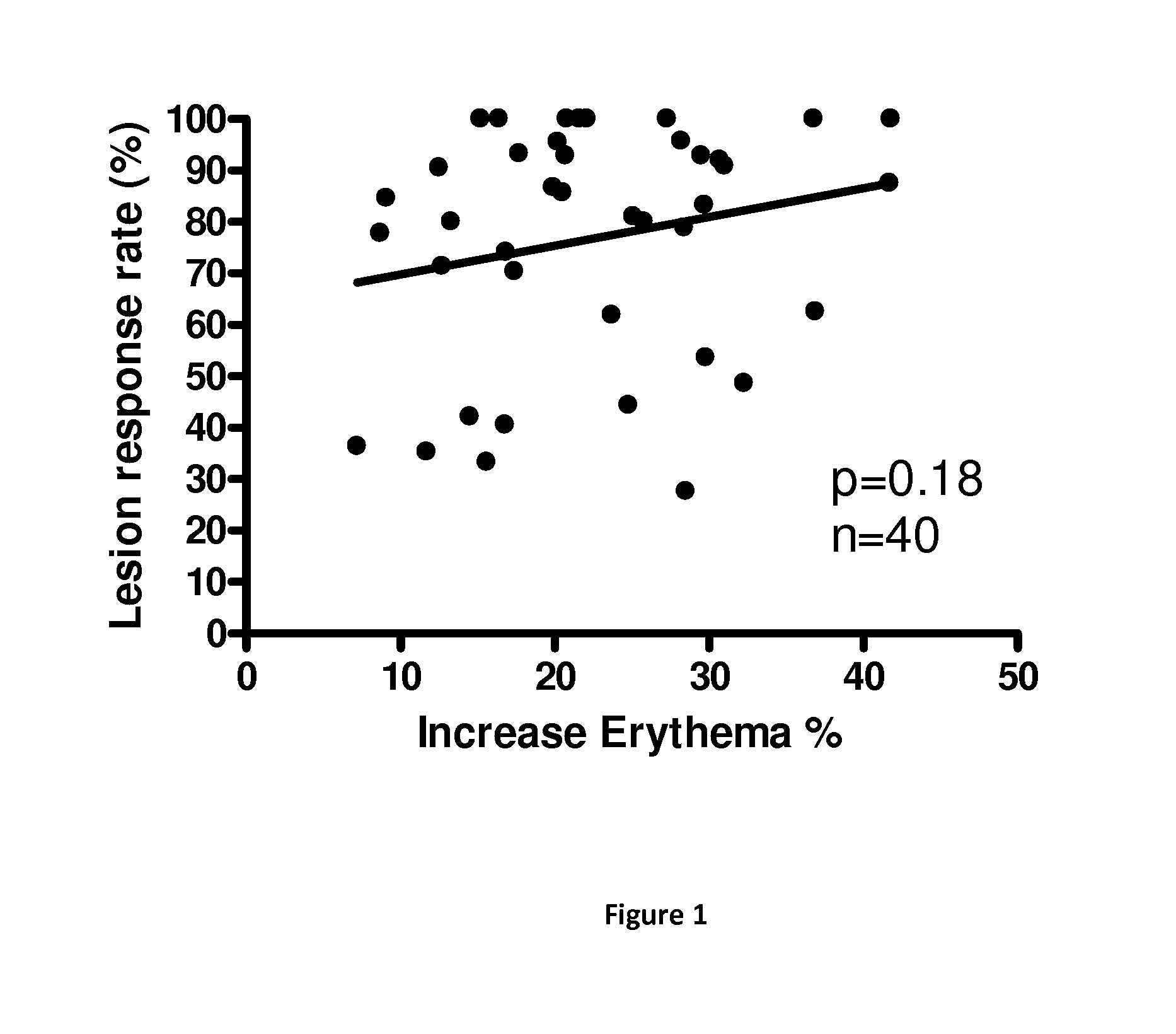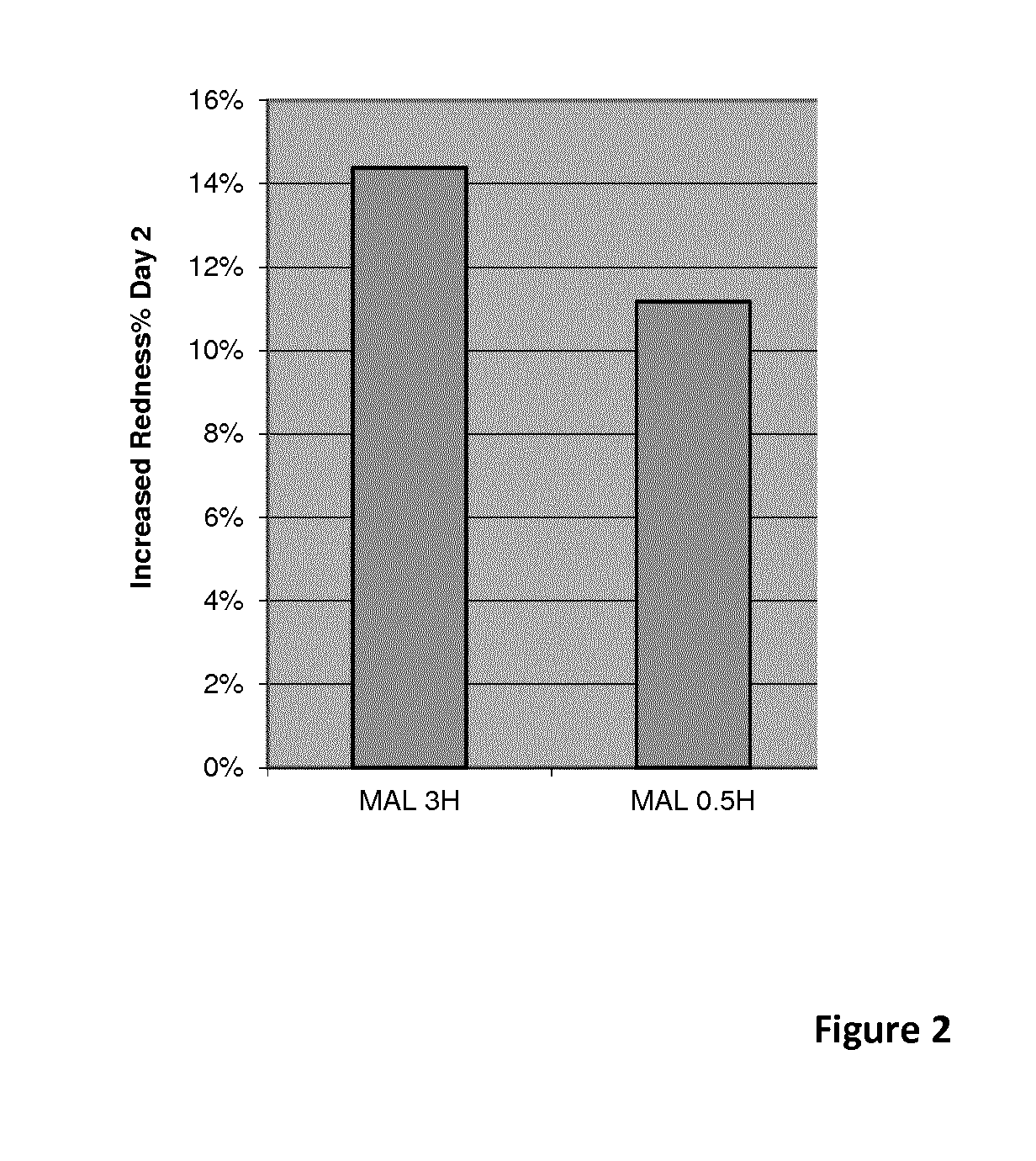Pulse photodynamic treatment of photodamaged skin
- Summary
- Abstract
- Description
- Claims
- Application Information
AI Technical Summary
Benefits of technology
Problems solved by technology
Method used
Image
Examples
example 1
Assessment of the Efficacy of a Daylight PDT in Subjects with Facial Photodamage
[0105]A double-blind randomized-controlled trial has been conducted to determine whether daylight PDT is an efficient method for treating photodamaged skin.
[0106]60 Subjects were randomized to receive 1 gram of topical methyl aminolevulinate (MAL) applied to the whole face <30 minutes before sun exposure for 2 hours (3 sessions, 2 to 4 weeks apart) or matching placebo applied to the whole face <30 minutes before sun exposure for 2 hours (3 sessions, 2 to 4 weeks apart) in a double-blind fashion. Neither the investigator nor the patient knew which agent was administered, as it was applied by a trained professional nurse. To enhance product / placebo penetration a subtle abrasion with sandpaper of the whole face was performed. Also, a sunscreen (Cetaphil Dermacontrol SPF30®) was applied to the entire sun-exposed area including the treatment area in both groups during daylight-PDT, to avoid sunburn.
[0107]Effi...
example 2
Comparison of Mechanical Penetration Enhancers on Photosensitizer Skin Penetration
[0112]The effect on the product skin penetration of different mechanical penetration enhancement techniques (occlusion, microneedles, ablative fractional laser) has been evaluated.
[0113]10 healthy volunteers have been treated according to the following protocol:[0114]pretreatment with either micro-needles (Dermaroller) or ablative fractional laser (CO2 laser fraxel repair (SOLTA)), or no pretreatment;[0115]application of Metvix;[0116]3 hours of incubation with or without occlusion.[0117]Penetration was quantified during incubation using measurement of photo fluorescence of PpIX at 30 minutes, 1 hour, 2 hours, and 3 hours after product application.
[0118]Both Dermaroller and laser similarly increased Metvix penetration in surface and deeper skin as measured by blue (405 nm) (see FIG. 10) and red (632 nm) (see FIG. 11) photo fluorescence as compared to no pretreatment without occlusion and no pretreatment...
example 3
PDT Procedure Change to Minimize Inflammation in PDT
[0122]According to the just mentioned theory it would be preferable to keep PPIX and cellular enzymes away from the extracellular compartment, thereby avoiding inflammation.
[0123]The purpose of this project is therefore to keep the PPIX formation within the mitochondria and avoid excess amounts of PPIX to be formed. Simultaneously PPIX should be allowed to be formed for such a long time that most unnormal cells will be affected.
[0124]So the purpose of PDT is to kill unnormal cells, preferably by apoptosis. The ideal situation would be to keep PPIX inside the cell and to destroy the mitochondria only, thereby inhibiting the ATP formation necessary for cell functions. That should result in cell death by apoptosis.
[0125]One possible way to achieve this would be to give a short 5-MAL pulse treatment to get a high concentration of 5-MAL in the cells initially and then diminish further access to 5-MAL by removing 5-MAL from the skin surf...
PUM
| Property | Measurement | Unit |
|---|---|---|
| Time | aaaaa | aaaaa |
| Time | aaaaa | aaaaa |
| Time | aaaaa | aaaaa |
Abstract
Description
Claims
Application Information
 Login to View More
Login to View More - R&D
- Intellectual Property
- Life Sciences
- Materials
- Tech Scout
- Unparalleled Data Quality
- Higher Quality Content
- 60% Fewer Hallucinations
Browse by: Latest US Patents, China's latest patents, Technical Efficacy Thesaurus, Application Domain, Technology Topic, Popular Technical Reports.
© 2025 PatSnap. All rights reserved.Legal|Privacy policy|Modern Slavery Act Transparency Statement|Sitemap|About US| Contact US: help@patsnap.com



